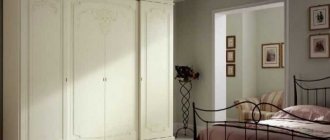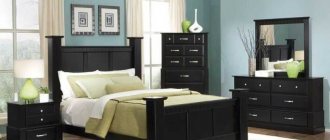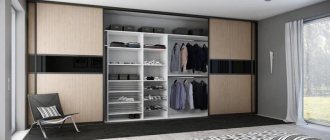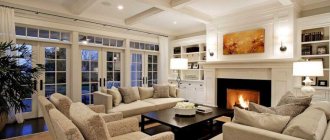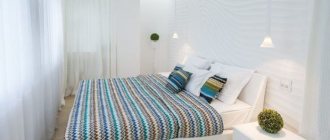2019-06-17
Author: Belfan
From this article you will learn:
- How to create a house plan with furniture placement
- What are the basic rules for arranging furniture in the house?
- What are the ways to arrange furniture in the house?
- How to arrange furniture in the living room
- What should be the arrangement of furniture in the kitchen?
- How to arrange furniture in the bedroom
- How to arrange furniture in a country house
Each room has its own function. And it doesn’t matter if it’s a huge cottage or a simple work office, a small cozy apartment in a remote part of the city or a souvenir shop. Also, every place has its own atmosphere and style. Therefore, it depends only on you whether the room will be comfortable and cozy. And if we consider the living space, then the correct arrangement of furniture in the house is especially important in this matter. This is exactly what we will talk about in our article.
House plan with furniture arrangement
It is well known that pieces of furniture are necessary to create human comfort. We have an idea of the furnishings we need in a room, but we don’t always think about how best to arrange them. This is a mistake, since it is necessary to arrange furniture in the house in accordance with the design of the room. And in order to fully use all the possibilities of this space, you need a plan for arranging objects.
Any room in a high-rise apartment or in your own home must perform a specific function. And the arrangement of furniture implies an individual approach, taking into account the characteristics of the room and the preferences of the owners. Some people don’t like it when a dining table is placed in the living room, while for others this is the norm, because the purpose of the living room is to welcome guests at a set table in a beautiful setting.
To draw up a plan, you will need to know the width and length of the room, as well as a list of furniture items to be placed. You can plan on paper, that is, draw a room on a scale of 1:3, cut out paper models of furnishings, observing the proportions, and “arrange” them to find a suitable option.
Also today there are convenient computer programs for 3D planning.
Recommended articles on this topic:
- Furniture consoles in Provence style: how to choose and where to put them
- Natural wood sofas: the right tips for choosing
- Living room interior in warm colors: a cozy room without flaws
Style
In fact, there are practically no restrictions; the choice of one or the other depends on:
- fashion trends, current trends this season. It is better to give preference to one of the modern styles. Classic is not the best option;
- your taste, as well as the style you adhere to;
- how the rest of the rooms are decorated. Of course, if you didn’t plan to play on the contrast of the rooms from the beginning;
- what is more important - functionality or appearance. Although designers often try to combine as much as possible, such a compromise does not always lead to a positive result;
- most importantly, the size and shape of the room. It has already been said more than once or twice that this is what is decisive.
If you are not at all confident in your own abilities, seek help from a specialist. It is always more expensive to redo it than to do it well right away.
Basic rules for arranging furniture in the house
All rooms in the house serve their purpose and have their own characteristics. Therefore, when arranging furniture, you need to adhere to the following universal principles:
- As we have already said, first of all you should find out the dimensions of the room and each piece of furniture. It will not be difficult to sketch out a diagram of the room in large-scale proportions on graph paper and cut out cards from the paper in proportional sizes to represent the furniture. Then “arrange” this furniture on the plan and choose your favorite option.
- To properly organize the space in the setting, you need to highlight the main element of the interior. In the living room it could be a fireplace, a television panel, or an unusual painting. For the bedroom, the main interior object is the bed, and for the kitchen - the dining table.
- What distance should be between pieces of furniture? It is necessary to leave 1.8–2.4 m of free space so as not to feel cramped. In a furnished room, a person should feel freedom and comfort.
- It is important to use the corners of rooms wisely. In narrow rooms or old “Khrushchev” buildings, you can put something that does not attract attention, for example, a compact shelving unit, a small corner closed or open cabinet, or a floor vase.
- An acceptable distance between the sofa, table and chairs is considered to be 0.6–0.8 m. There should be a comfortable arm’s length distance between your guests during tea drinking and communication.
- It is better to hang pictures above eye level - this technique will visually increase the space. In a room with two windows, you should hang a mirror on different walls. It will add light and double the volume of the room.
- A small narrow room will be made more spacious by light, compact furniture. Just don’t put a lot of souvenirs, photographs and other trinkets on the shelves.
What is ergonomics
The third stage is to involve science. Yes, yes, you can’t go anywhere without her. Ergonomics will help us. This is the science of the proper organization of space during human interaction with the environment. In other words, how to adapt the interior to suit yourself so that it is physiologically and psychologically comfortable? So, from an ergonomic point of view, it is necessary to take into account the following parameters:
- The dimensions and height of the furniture, taking into account this time the dimensions of a particular person, that is, yours.
- The location of door handles, switches, sockets so that it is convenient for you.
- Placement of light sources in a room depending on its functionality.
- Determine the optimal distance between furnishings.
- Ensure free and unhindered movement around the room.
Ergonomics helps make a typical room exactly yours, taking into account all anthropometric and physiological characteristics. Just remember to consider the needs of the rest of the family, especially children. Ergonomics advises to take even pets into account.
Ways to arrange furniture in the house
Here are some basic principles for arranging furniture in a private home:
- Symmetric. As the name suggests, furniture is arranged symmetrically, in pairs. The center is determined, and identical objects are placed at equal distances from it. The centerpiece can be any place or object in the room, such as a window, fireplace, TV or painting - and this object does not have to be placed in the center. For this arrangement it is better to use small pieces of furniture. For a square room, this will be an ideal option for distributing the furnishings. An example of symmetrical placement is a fireplace and a pair of identical armchairs near it or a bed with two bedside tables on both sides. Furniture must be in the same style.
- Circular. In this case, the central element is a chandelier or table. The rest of the furniture is placed around. With this method, you can combine items that differ in style into one ensemble. Circular arrangement is best used for spacious rooms. We must remember that the room must have free space for movement. This option is also suitable for a hall with semicircular walls.
Some details about built-in wardrobes
Next we will talk about built-in wardrobes. They are very convenient, occupy unused space, so even very large ones do not look bulky. Free-standing cabinets are already equipped with shelves, drawers, sections, while built-in ones always correspond to your personal needs; you create their contents yourself. Built-in wardrobes allow you to mask layout flaws. The growing popularity of these models is easy to explain.
But before you invite a master, you must accurately calculate its dimensions and determine its location - it will be impossible to move it.
Built-in wardrobes come in several types:
- Direct. The simplest ones, suitable for any room.
- Corner ones are very compact, save space, and are suitable even for narrow rooms.
- Radial ones – these ones fit well into a niche.
The location of the cabinet also determines its contents. Will it be a linen closet for the bedroom, a wardrobe for the living room, or a wardrobe for outerwear in the hallway. When ordering a cabinet from a craftsman, you must clearly understand its contents: what shelves, drawers, holders and rods should be there. To do this, make a complete list of things and add about 20% for the expansion of your wardrobe. Next, group things according to the principle of storage - what will lie on the shelves, what will be in drawers, what will hang on hangers. Now it should be clear to you how many shelves and drawers you will need, and how long the bar should be. Two sizes of a built-in wardrobe are considered more or less constant: depth - at least 60 centimeters, otherwise you will not be able to hang hangers on the longitudinal rod; if you have sliding doors, then they will require another 8 centimeters for the mechanism; width 180-185 centimeters, this is dictated by the size of the doors. The height can be whatever you want, as the dimensions of your room allow.
Also think about the material for your closet in advance. You can choose from laminated chipboard, fiberboard, MDF and chipboard. The most popular is chipboard. It attracts with its durability, variety of design, resistance to mechanical stress and price.
How to arrange furniture in the living room
It is customary to welcome guests in the living room, so you need to create the most comfortable environment for everyone: the people who come to you should feel comfortable. When arranging furniture, think first of all about the ability to move freely around the room. But there is no need to go to extremes: there should be enough furniture for everyone to sit. In general, the installation of each item must be justified, since guests need to move around without fear of touching an expensive vase or floor lamp.
A stuffy and overloaded living room will leave an unpleasant impression on your guests. It is advisable not to place bulky, tall furniture in it. It is better to avoid this type of product when you are working on a house project with furniture arrangement.
The initial data is also the dimensions of the living room: in a small room it will seem more space when the armchairs, sofa, coffee table and shelves are arranged without maintaining symmetry. In a spacious room, you can use a circular or symmetrical arrangement.
Lighting and decor
Grouping furniture, in principle, will help avoid clutter. Agree, a comfortable soft corner for two, or maybe a whole company, is much nicer than a set of fashionable but impractical items.
The decor will help in arranging the necessary vertical accents.
Lighting is necessary both general and accentuating. We use floor lamps, wall and table lamps.
Plants, especially tall ones, are good not only for large rooms. They will brighten up the voids and significantly improve the overall appearance of the room.
Arranging furniture in the kitchen
For rational placement of furniture in the kitchen, the triangle principle is suitable:
- The stove and sink are located a short distance from the wall.
- There is space for a refrigerator on the opposite wall.
- You should get something like an isosceles triangle. With this arrangement, the housewife can easily and freely move in her kitchen while cooking.
If possible, the dining area should be placed somewhat further away from the kitchen, because nothing should interfere with the creative process of preparing culinary masterpieces.
If the kitchen is long and narrow, a parallel arrangement of work lines will do. The most convenient width between surfaces is about 110 cm. In a small kitchen, they use the U-shaped method of placing objects and the triangle rule for installing a sink, stove and refrigerator. Kitchenettes use an L-shaped arrangement.
How to arrange furniture in the bedroom
In the bedroom, the furniture set is usually arranged symmetrically, since this room is intended for relaxation and there is no place for extravagance.
A central place is usually allocated for the bed, with the headboard facing the wall, and a bedside table with a lamp is placed on each side. In front of the bed you can place a chest of drawers with a TV or mirror. A closet against one of the walls completes the ensemble.
It is more difficult to achieve a symmetrical arrangement if the bedroom is combined with a study: the place to work will introduce dissonance into the energy of the room. You will have to balance the decor with similar pieces of furniture, placing them on opposite sides. This way you can create harmony in the interior.
As an option, buy a desk made of similar material; It will also be possible to balance the situation by placing a chest of drawers or a cabinet. A beautiful screen can become a partition, and you can also work with the lighting or highlight the area with a different wall color.
In a small bedroom, you can place the bed along the wall, so it will not interfere with the passage. Keep in mind that according to Feng Shui, the bed should not be placed opposite the door. Installing a beautiful wardrobe can serve as a starting point for arranging furniture.
Having decided on the position of the wardrobe, you can arrange the rest of the furniture. For a dressing table, you can find a place at the foot of the bed or place it in a corner by the window. It would be nice if there was room left for a brightly colored ottoman or a small armchair with cushions.
Features of the children's room furnishings
Particular attention should be paid to the zoning of the children's room. Especially if it is intended for two or more children. The children's room “grows” with the child; its interior is the most changeable. But the requirements for furniture remain the same: it must be safe, practical and functional. Safe means:
- Made from natural environmentally friendly materials.
- Reliable and stable, but not heavy.
- Has no sharp corners.
- Suitable for the child's age.
The children's room should contain: a sleeping area - a sofa or bed, a playing area - a carpet, drawers and boxes for toys, an activity area - a desk, chairs, shelving and a bookcase. You also need to place a wardrobe, shelves and chests of drawers. It seems impossible to combine all this in one room and still have enough free space for games. It is sometimes impossible to do without combined furniture.
Furniture arrangement in a country house
In a country house, the living room and kitchen are usually located next to each other on the ground floor or these rooms are combined into one large one. The living room usually serves as a gathering place for the whole family, where they meet with friends and spend evenings drinking tea in pleasant company.
In a large combined kitchen-living room space, it is worth zoning into such parts as:
- kitchen;
- area with dining table;
- a place to relax and receive guests.
If there is a stove or fireplace in the living room, then the arrangement of furniture in the house in the village should be planned from this central element. Their presence suggests a rustic-style setting. Choose tables, chairs and cabinets made of natural wood to make the interior look cozy and warm. The arrangement of furniture in a wooden house should be done in such a way that objects are not too far from the warm stove, but not too close either, otherwise it can be very hot.
A repaired and whitewashed Russian stove, even when not used to heat the house, looks stylish in the interior and serves as a kind of “highlight” of the room. Adults who grew up in the village find it especially pleasant to be in the atmosphere of their childhood.
It is important to position the lighting fixtures so that the light from them is weaker than the fire from the fireplace. Do not clutter the room with large objects; choose light furniture in light colors.
If the kitchen is in the same space as the living room, then place a minimum of furniture: a small light sofa with a natural wood tone frame, a wall-mounted television panel. Place a transforming table near the sofa - this model serves as a coffee table, but if necessary, it can be easily expanded into a large dining table.
A large room can be zoned with a bar counter, behind which the kitchen will be located. In this way, it is easy to define the boundaries between the cooking area and the living room - a place where you can enjoy eating it. In addition, a bar counter will add an interesting element of modernity to a country interior.
Studio apartment
A studio apartment is a space with an area of 30-40 m². When planning a room for different zones, it is necessary to create a design project; for this, use special applications or a regular sheet of paper to create a rough layout of the future apartment. How to furnish a studio, advice from designers:
- Before purchasing furniture, fittings, etc., divide your living space into three zones - kitchen, bedroom and living room.
- Each family member should have their own personal space.
- You should not clutter the area with unnecessary items that residents can do without. This is important for creating the image of free space, because a person in an apartment should feel free.
Note! To zone the space, use curtains, screens, and partitions. You should also place a bookcase or chest of drawers to define zones.
Most often, the following styles are chosen for a studio apartment:
- minimalism;
- Scandinavian;
- high tech;
- Japanese.
High-tech, pop art or modern styles are also suitable for small spaces. But in no case use a classic style with a lot of patterns, decorative elements or gilding, because they hide the already small space.
At first glance, it may seem that decorating your home beautifully and comfortably will not be difficult. But in reality, you will need to do a colossal amount of work - carry out proper zoning, select things according to shape, style and coordinate them with each other. To avoid mistakes, think through the interior in advance and do not neglect the arrangement plan.
Final tips on how to properly arrange furniture in your home
- Pay attention to the levels. The height of the surface of the object is correlated with the area where it is located, for example, a coffee table standing in the corner of the living room should be higher than a coffee table, which is located next to the armchairs or sofa.
- Lighting also plays an important role in the interior.
- If the room has two exits, then it is necessary to leave free space between them for a passage, which can be straight or, for example, arched, representing a corner for guests that needs to be walked around. With such a corridor you can divide a large hall into separate zones. Also, certain pieces of furniture can be used to zone spacious rooms in country houses (for example, made of timber). The arrangement of furniture should be planned in advance. For example, a stylish shelving unit or a high back of a sofa can become the very elements that divide the space.
- When arranging furniture, leave room for free movement in the room.
- Before purchasing carpets that will look harmonious with the furniture you have chosen, you need to decide on the size of the place where you want to put them.
- You can decorate a small room with long curtains, and the ceilings will appear higher. At the same time, in such a room it is better to place light, compact furniture of a simple shape. Do not overload the interior with a large number of paintings, souvenirs, photographs and other small details.
- It is best to place accessories and furniture symmetrically: on both sides of the sofa there are paintings in the same style; shelves on both sides of the TV panel; a sofa and armchairs placed opposite in a checkerboard pattern. This method will create optimal proportions and harmonize the space.
Color solutions
It would seem that the answer is obvious: absolutely any. There are no limiting factors. But as practice shows, bright, especially dark options are frankly a bad choice. There are three reasons:
- visually they make the room heavier. Just being in it can be uncomfortable, not to mention resting or relaxing after a hard day;
- It is very difficult to zone a room. Especially if you haven’t fully decided on the furniture or arrangement;
- dark walls narrow even an open room. Whereas if there are pieces of furniture in it, then a full-fledged living room turns into a “corridor”.
Finally, the calculated light sources may simply not be enough for proper illumination. And you will have to either change or install additional sconces/floor lamps. And this is a significant increase in the budget, which will already be quite large.

